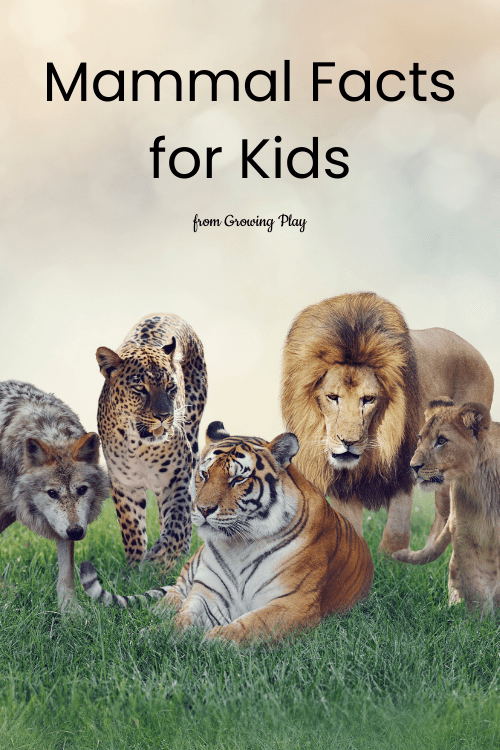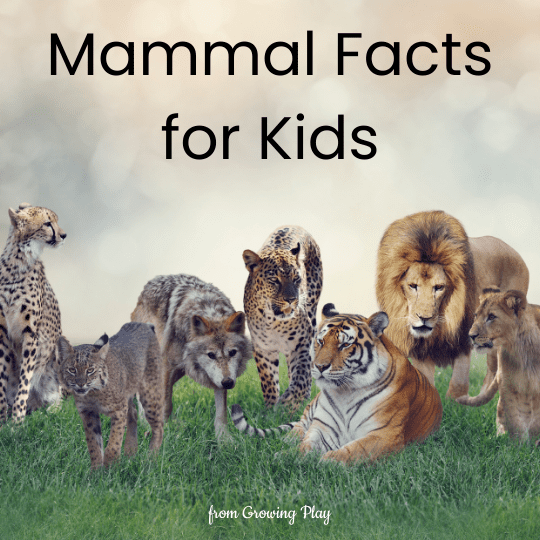Mammal Facts for Kids

From polar bears, to baleen whales, sea otters, and even humans there are so many different kinds of mammals. There are large mammals, such as the brown bear and small mammals, such as the tiny bat. What types of mammals can you name? Did you know humans are mammals too? That’s right! Mammals are characterized by having fur or body hair and the ability to produce milk for their young. Keep reading these mammal facts for kids to learn more about these incredible creatures. We will cover it all from the very first mammals to mammals that are still alive today, so get ready to learn!
The First Mammals
1. Mammals evolved from mammal-like reptiles during the Triassic period, around 200 million years ago.
2. The first mammal is thought to be a small animal called Haldanodon, which lived in what is now Scotland.
Mammal Facts for Kids – The Different Types of Mammal
3. There are about 5,000 species of mammals between land mammals and marine mammals This makes them the largest group of vertebrate animals, or animals with backbones. Many mammals also have neck vertebrae, or bones near the top of their head.
4. The largest mammal and largest species of whales is the blue whale. Blue whales can grow up to almost 100 feet long! That’s one huge whale!
5. The largest land mammal is the African Bush Elephant. These elephants can weigh upwards of 15 tons! Wow!
6. The smallest mammal is the bumblebee bat, which has a wingspan of just 6 centimeters (2.4 inches) and weighs less than 2 grams (0.07 ounces).
Characteristics of Mammals
7. Mammals are warm-blooded animals, meaning they can maintain a constant body temperature regardless of the surrounding temperature.
8. Most mammals are endothermic, meaning they generate their own body heat through metabolic processes such as digestion and muscle activity.
9. Some mammal species, such as whales and bats, are ectothermic, meaning they rely on external sources of heat to warm their bodies.
Mammal Facts for Kids – What Makes a Mammal, a Mammal?
10. All mammals have fur or hair, which helps to keep them warm by trapping heat close to the body.
11. Only mammals have mammary glands, hence the name “mammal”. Mammals are the only animals with these special glands that produce milk for their young.

Animal Care Pretend Play Packet
Where Can You Find Mammals?
12. Mammals are found on all continents except Antarctica. They are located in North America, South America, Europe, Asia, Africa, and Australia.
13. Some mammals, such as killer whales can also be found in fresh water or salt water. These are known as marine mammals or aquatic mammals.
Mammal Facts for Kids – Reproduction and Parental Care
14. Female mammals give birth to their babies, rather than other animals who watch their young hatch from eggs. Another key characteristic of mammals is that they give live birth.
15. Mammal mothers typically care for their young until they are old enough to fend for themselves.
Mammal Diets
16. Most mammal species are herbivores (plant-eaters), although some (such as lions) are carnivores (meat-eaters).
17. Some mammal species, such as koalas and pandas, have a diet that consists almost entirely of one type of food.
18. Many mammal species are scavengers, feeding on the carcasses of dead animals.
19. Some mammal species, such as bats and dolphins, use echolocation to navigate and find food. Do you know what echolocation is? It is the act of using sound rather than sight to search and find something. How cool is that?
Mammal Facts for Kids – Mammal Communication
20. Mammals have well-developed brains and are some of the most intelligent animals on Earth.
21. Some mammal species, such as chimpanzees and dolphins, are able to communicate using sign language or symbols.
22. Mammals are capable of complex emotions such as love, grief, anger and fear.
The Daily Lives of Mammals
23. Most mammal species are social animals that live in family groups, although some (such as lions) are solitary.
24. Mammal groups can vary in size from just a few individuals to hundreds or even thousands.
Mammal Facts for Kids – Adaptations of Mammals
25. Some mammal species are adapted for life in the desert, such as camels and kangaroo rats. Others are adapted for life in cold environments, such as Arctic foxes and reindeer.
26. Many mammal species are able to swim and some species have adapted for life in the water, such as seals, whales, and dolphins.
27. Some mammal species, such as bats and mice, are capable of flight. Others, such as kangaroos and rabbits, have powerful hind legs that enable them to jump great distances. Every mammal has adapted to their environment in different ways. How have you adapted to your environment?
Let’s Summarize!
Most mammals are terrestrial (land-dwelling), although some (such as bats) are arboreal (tree-dwelling), and some even live in the water! What’s your favorite species of mammal? Maybe you like the elephants for their large ears and feet or maybe you think the spiny anteater looks cool. Whatever your favorite mammal is, I encourage you to keep researching them so you can learn even more about these amazing animals.
WANT MORE FUN FACTS FOR KIDS?
Check out these fun facts for kids here and browse all the other topics at the bottom of the post.



